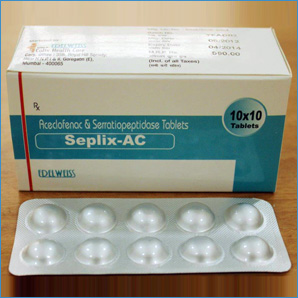
SEPLIX AC
(Aceclofenac IP 100 mg+Serratiopeptidase 10mg)
Aceclofenac is an orally administered phenylacetic acid derivative with effects on a variety of inflammatory mediators. It is from the class of non-steroidal anti-inflammatory drug (NSAID), related to diclofenac. Through its analgesic and anti-inflammatory properties, aceclofenac provides symptomatic relief in a variety of painful conditions.
PHARMACOLOGY
The mode of action of aceclofenac is largely based on the inhibition of prostaglandin synthesis. Aceclofenac is a potent inhibitor of the enzyme cyclo-oxygenase, which is involved in the production of prostaglandins. Aceclofenac has been shown to exert effects on a variety of mediators of inflammation. In patients with osteoarthritis of the knee, aceclofenc decreases pain, reduces disease severity and improves the functional capacity of the knee. It reduces joint inflammation, pain intensity and the duration of morning stiffness in patients with rheumatoid arthritis. The duration of morning stiffness and pain intensity are reduced and spinal mobility improved, by aceclofenac in patients with ankylosing spondylitis.
PHARMACOKINETICS
Aceclofenac is rapidly and completely absorbed after oral administration. Peak plasma concentrations are reached 1 to 3 hours after an oral dose. The drug is highly protein bound (>99%). The presence of food does not alter the extent of absorption of aceclofenac but the absorption rate is reduced. The plasma concentration of aceclofenac was approximately twice that in synovial fluid after multiple doses of the drug in patients with knee pain and synovial fluid effusion.
Aceclofenac is indicated for the relief of pain and inflammation associated with rheumatoid arthritis, osteoarthritis or ankylosing spondylitis.
CONTRAINDICATIONS
Aceclofenac should not be administered to patients hypersensitive to aceclofenac or other NSAIDs, or patients with a history of aspirin or NSAID-related allergic or anaphylactic reactions or with peptic ulcers or Gl bleeding, moderate or severe renal impairment.
|
|
Usage in pregnancy and lactation
The drug is not recommended in pregnant or breast feeding women.
Usage in paediatrics
There are no clinical data on the use of Aceclofenac in children. Usage in geriatrics The pharmacokinetics of Aceclofenac is not altered in elderly patients, therefore it is not considered necessary to modify the dose or dose frequency.
Drug interactions
Drug interactions associated with Aceclofenac are similar to those observed with other NSAIDs.Aceclofenac may increase plasma concentrations of lithium, digoxin and methotrexate, increase the activity of anticoagulants, inhibit the activity of diuretics, enhance cyclosporin nephrotoxicity and precipitate convulsions when co administered with quinolone antibiotics. When concomitant administration with potassium sparing diuretics is employed, serum potassium should be monitored.
Serratiopeptidase :
Serratiopeptidase is a protein (proteolytic) enzyme isolated from the non-pathogenic enterobacteria Serratia E15 found in silkworms. Serratiopeptidase helps the fully-grown butterfly to escape from the cocoon. Serratiopeptidase has a particular affinity for dead protein molecules. Serratiopeptidase is known as proteolytic enzyme as the enzyme digests or breaks down proteib debris from toxins and inflammation. Serratiopeptidase digests away scar tissues, blood clots, cysts, mucus, arterial plaque and inflammation in all forms without side effects, It has been used successfully for almost 40 years in Japan and Europe for pain and inflammation due to arthritis, trauma, surgery, sinusitis, bronchitis, carpal tunnel and painful swelling of the breasts. There is some preliminary indication that it may be useful for atherosclerosis.
Therapeutic action :
Enzymatic compound with anti-inflammatory and anti-edematous properties. Bronchial secretion fluidifier.
Indications:
Trauma Surgeries :
In sports injuries, sprains, lacerations, fractures and dislocation. Reduces inflammation abd helps faster healing and repair of injured tissues.
Surgery :
Reduces post operative oedema at injection sites. Reduces internal tissue oedema caused by post operative handling. Reduction in oedema reduces chances of rupture ar tissue site as well as risk of graft rejection.
Plastic Surgery :
Reduces post operative oedema and restores microcirculation at the site of graft rejection,
|
|
Respiratory Medicine :
Breaks down complex sputum molecules in smaller peptides with lower viscosity, helping in expectorating them more easily. Reduced viscosity of secretions helps in better antibiotic penetration to enable control over stubborn infections like bronchitis, lung abscess and broncheitasis.
Infections :
Mucolytic activity in sinuses, ear cavities and anti inflammatory activity in upper respiratory tract organs help in faster resolution ,better antibiotic bioavailability and faster cure rates.
Male Genital Infections :
Restores microcirculation and augments antibiotic penetration in these organs which are known to produce poor antibiotic availability.
Dermatology :
Used in acute painful inflamed dermatoses.
Dentistry :
Helps better controll over dental infections.
Obstetrics & Gynaecology :
The anti inflammatory activity helps in resolution of post partum haematomas. breast engorgements, and pregnancy related thrombophlebitis,
SEPLIX AC INDICATIONS
In musculoskeletal and joint disorders such as rheumatoid arthritis, osteoarthritis and ankylosing spondylitis; peri articular disorders like bursitis and tendonitis; soft tissue disorders such as sprains and strains; and other painful conditions like renal colic, acute gout, dysmenorrheal, migraine, post operative oedema; inflammation and oedama associated with trauma, infection, respiratory tract congestion, chronic venous insufficiency; actinic keratoses and fever.
ADVERSE EFFECTS
Abdominal pain, constipation, diarrhea, dyspepsia, flatulence, heartburn, nausea, GI ulcers (gastric/duodenal) and vomiting. Abnormal renal function, anemia, dizziness, elevated liver enzymes, headaches, increased bleeding time, pruritis, rashes and tinnitus.
DOSAGE:
1 TABLET TWICE A DAY. |



